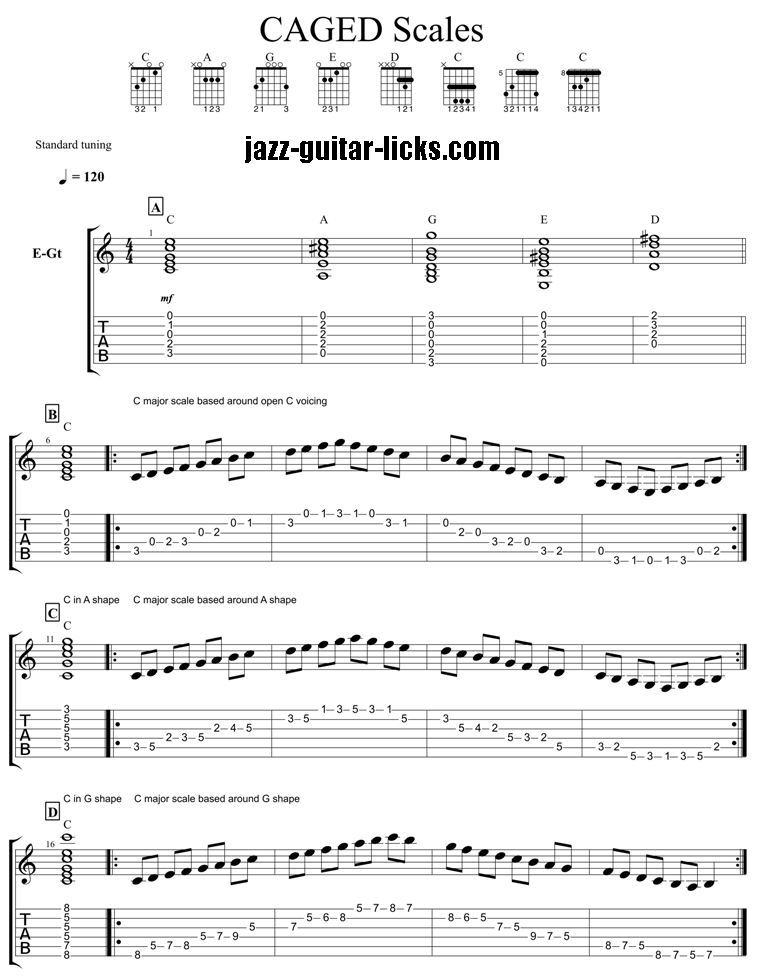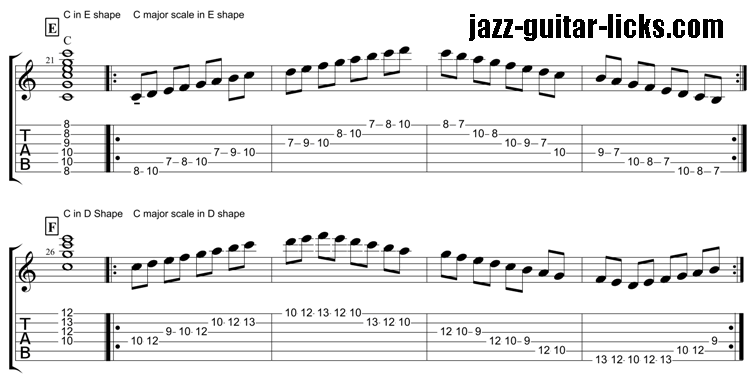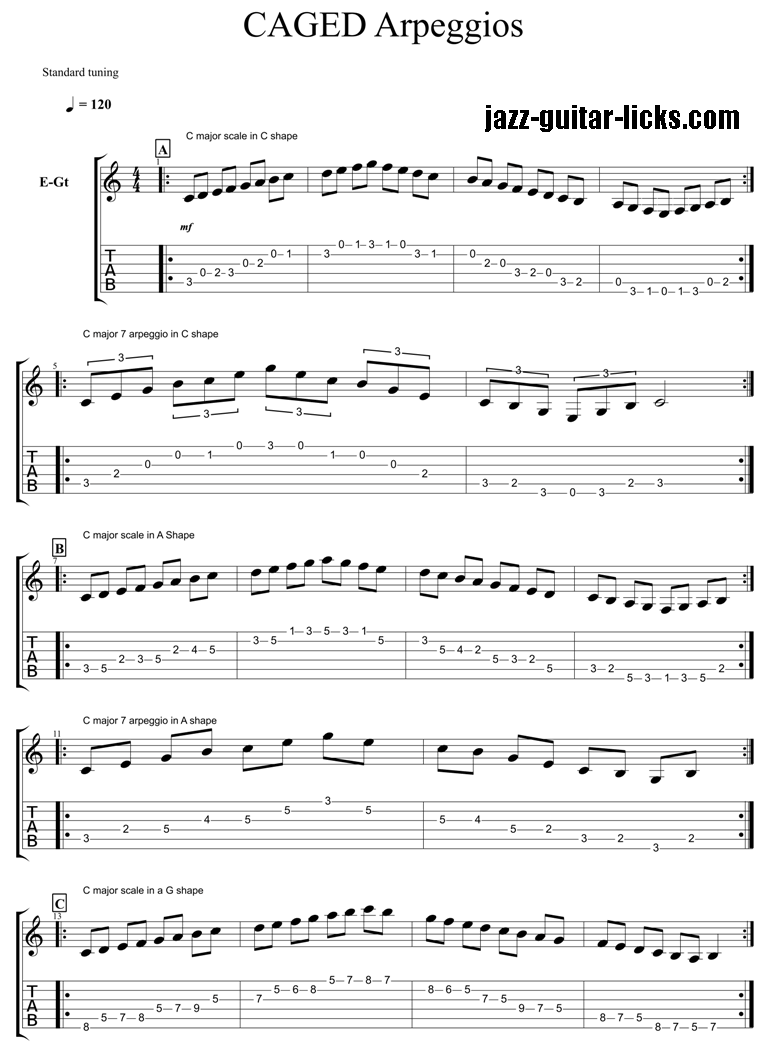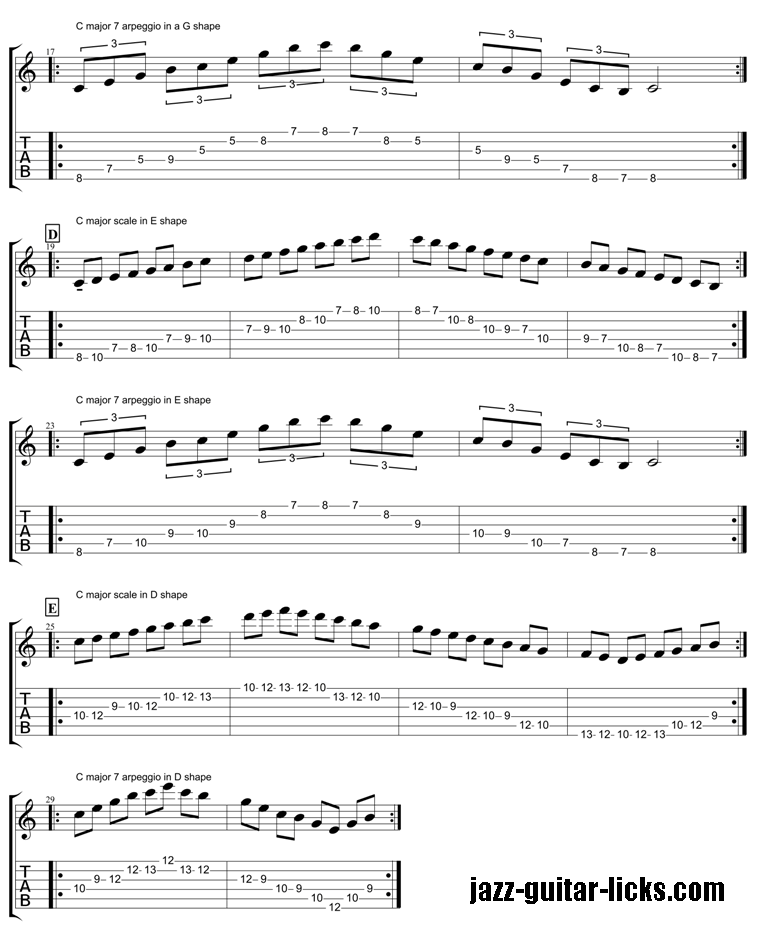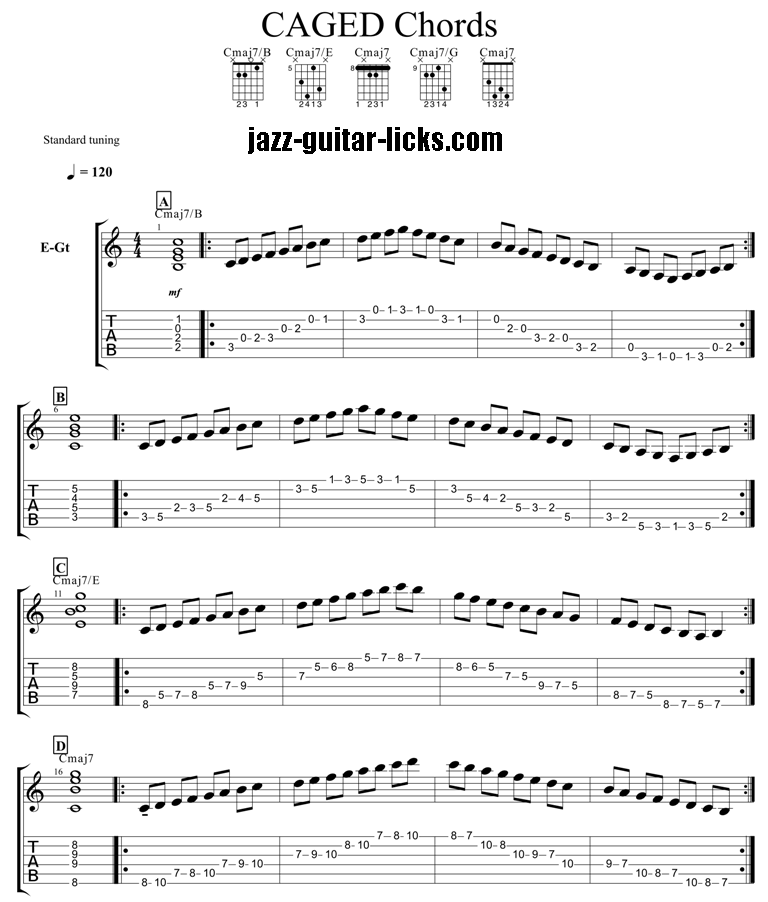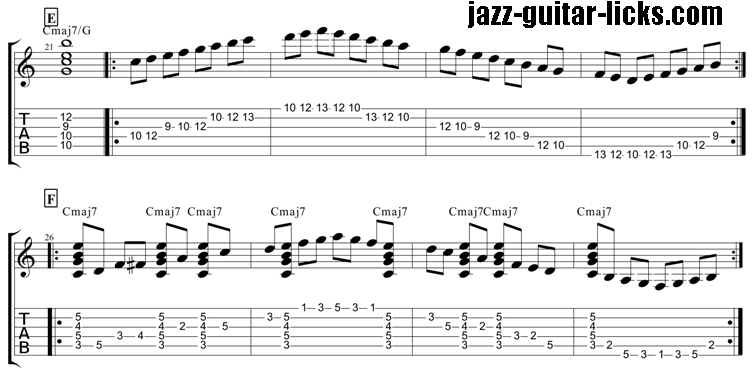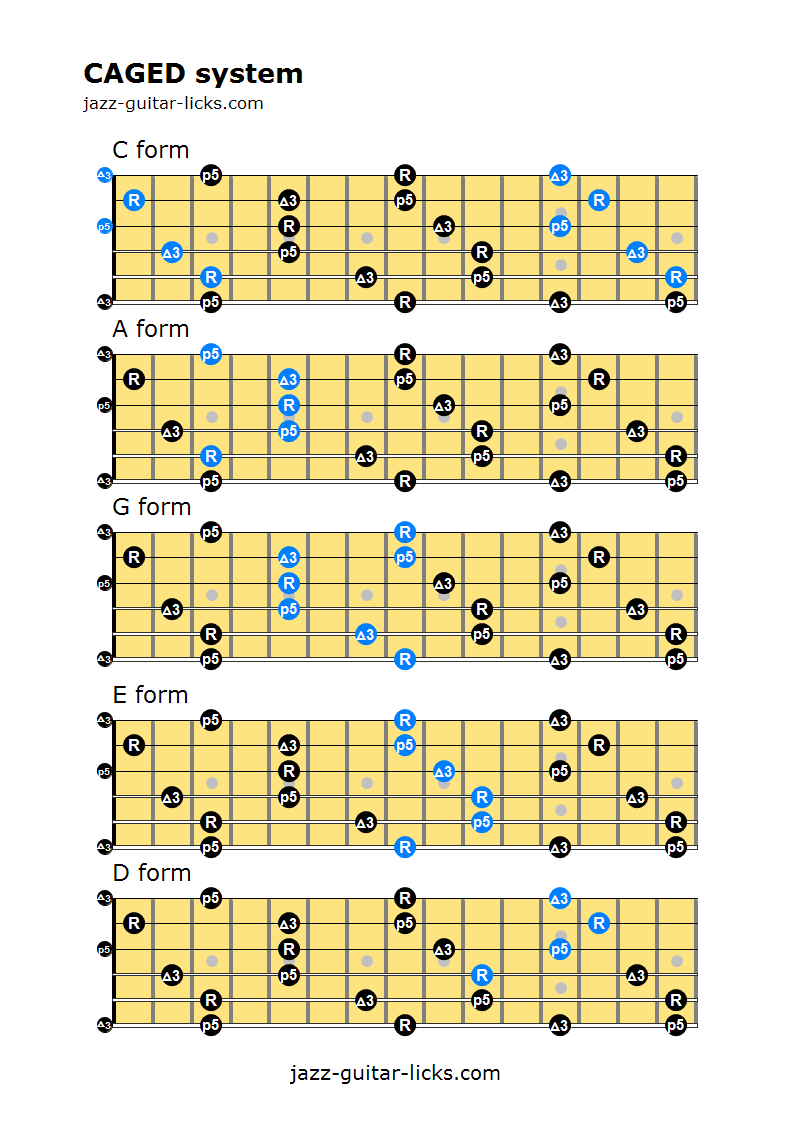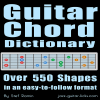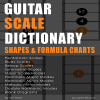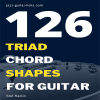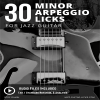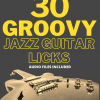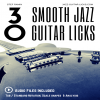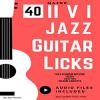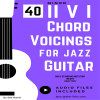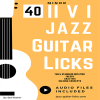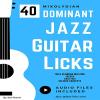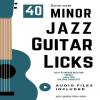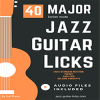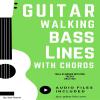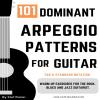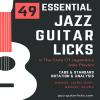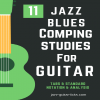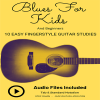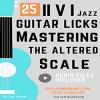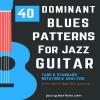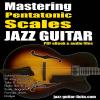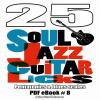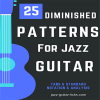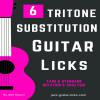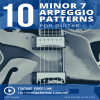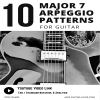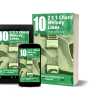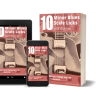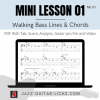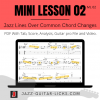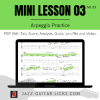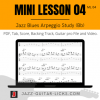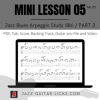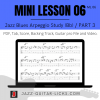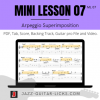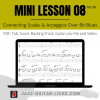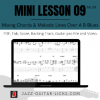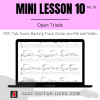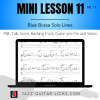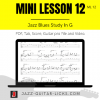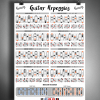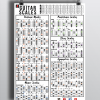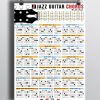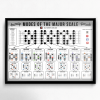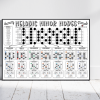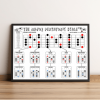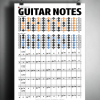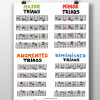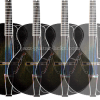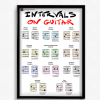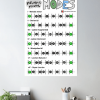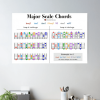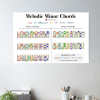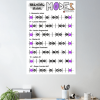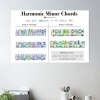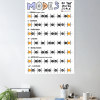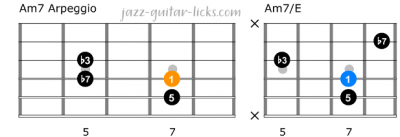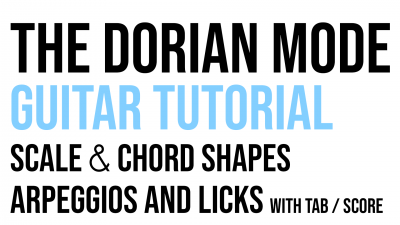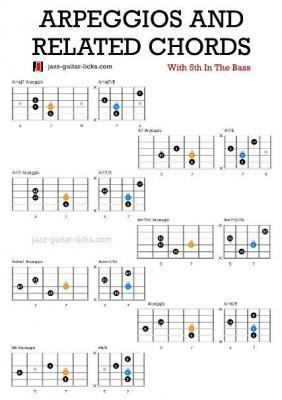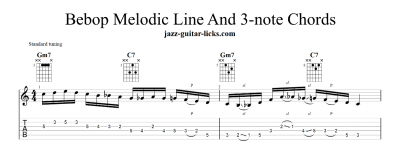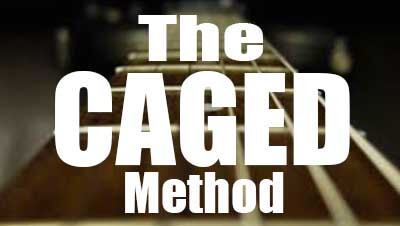
The CAGED Method For Guitar - Scales, Chords And Arpeggios
- By jazz-guitar-licks
- On 2017-12-24
- In Guest Posts
- 2 comments
Welcome to this guitar lesson on the CAGED method!
If you're looking to enhance your understanding of the fretboard, The CAGED method is a powerful system that will help you visualize and navigate the guitar in a more cohesive and comprehensive way.
Introduction
When I first joined my high school jazz band, it was a humbling experience.
I knew my major scales and modes, but only with the roots on the E and/or A string. This worked fine for playing pop music, but the way jazz progressions were always changing chords with each measure, my hands were constantly getting lost.
If I was playing a C major line in eighth position, how did I switch to a Bb mixolydian scale without jumping my hand up or down and making the improvisational idea totally disjointed ?
I could never understand how jazz guitarists could keep their ideas going as the chords changed from moment to moment.
And how did players like Joe Pass know how to run an improvised line right into a chord voicing?
Additionally, as I progressed to the higher registers of the guitar, I could never tell where I was in the scale anymore. It seemed impossible!
This problem continued for me until I discovered Will Leavitt’s book, A Modern Method For Guitar.
In this master work, the author breaks down a total of nine different fingerings for each scale.
After working through the books, I found myself completely able to find my way around a scale anywhere on the neck and easily select the next scale shape for whatever chord was upcoming.
His method is an advanced application of the idea that we can move common open triad shapes (cowboy chords) up the fretboard and build scales, arpeggios and chords voicings around each.
This concept is commonly called the CAGED method.
What is CAGED ?
For those unfamiliar with CAGED system, we start by playing the open chords C-A-G-E-D that spell out the word CAGED (CAGED Scales Example A).
In the key of C, we will travel horizontally up the neck, placing each voicing in the word CAGED on each pitch subsequent C we find.
For instance, an A chord, having a root on the fifth string, will fit at the third fret of the fifth string.
The G, having a root on the sixth string, will fit at the C on the eighth fret of the sixth string, giving us a shape in fifth position.
And so on, until we come back to C shape an octave above where we began.
From here, we will beginning building scales that fit around each shape (CAGED Scales Examples B-F).
Each chord shape has multiple scale shapes we could use, but I have limited it to one per chord for the sake of simplicity.
I suggest you do the same initially.
Each pattern encompasses what the hand would naturally be able to access by only shifting the outside fingers up or down one fret.
Now we have effectively built scale shapes that are organized relative to musical and physiological structures as opposed to the construction of the fretboard.
CAGED SCALES
How to Play a Scale in ANY Position on the Fretboard?
The first benefit of this approach is that we have a major scale shape we can apply at any position on the neck.
Now when confronted with difficult chord progressions our hand won’t have to jump up and down the fretboard to whichever of the two E and A-root scale shapes we can recall first. We can (with practice) visualize and shift to the next scale pattern seamlessly while staying in position.
One way I recommend practicing this is running scales up and down over a chord progression or tune while remaining in one position or area of the fretboard.
Relate Each Scale Shape to a Corresponding Arpeggio Shape
This approach can be further applied to other structures.
By isolating the chord tones of a major 7 voicing from each scale pattern we can construct arpeggio shapes that are wedded to each scale within our mind and hands (CAGED arpeggios Examples A-E).
This an invaluable concept to master.
Not only will be able be able to shift between arpeggios and scales smoothly, we will be aware whether any given not we are playing is a chord tone or tension.
To best acquire this skill, I recommend practicing each scale and corresponding CAGED arpeggio shape consecutively.
CAGED ARPEGGIOS
Relate Each Scale Shape to Corresponding Chord Voicings
Once we have our arpeggios in hand, we can begin to mine chord voicings from each shape.
This pays huge dividends when it comes to improvising in a solo guitar format.
There are a variety of chord that fit in each scale shape, but for our purposes here we will limit ourselves to the Drop 3 voicings that fall on 5th-2nd string (CAGED Chords Examples A-E).
As we progress through the inversions, we see there is a corresponding scale shape for each. Admittedly, the E pattern does not contain a Drop 3 voicing on this string set (Example D), but we will fit in a root position Drop 2 from the E string to bridge the gap.
To internalize this relationship, I recommend starting the scale at the lowest note in chord voicing by striking the chord (CAGED Chords Example F).
As you ascend and descend the scale, when passing through a pitch encompassed in the chord voicing, attack the chord voicing in lieu of the pitch itself.
This gives one all the options for where an improvised line can be intersected, begun or ended on a chord voicing.
CAGED CHORDS
Better Select Positions for Sight-Reading
I’ve also found this tactic helpful in sight reading.
If one begins by checking the key signature, it can be determined from which major scale the piece is likely derived.
By next selecting a scale shape which includes both the highest and lowest pitch in a given piece, one insures their hand will be in a position to grasp any pitch in the piece.
Even non-diatonic notes falling a half-step above or below any scale notes will be simple to locate as we are aware to which diatonic pitches they are adjacent.
For pieces with especially large ranges, we can shift between two or even three adjacent scale shapes.
The CAGED method is not limited to major scale usage as it can be applied to any scale or mode.
After learning of its benefits, I have personally applied this approach to every scale and mode I encounter.
Over time, I began to feel comfortable improvising and comping any set of changes over any position on the fretboard.
This is the approach I now teach and emphasize to my students regardless of the style they are pursuing because in CAGED the fretboard is organized around musical structures rather than organizing musical structures around the fretboard.
Try applying it to any scales you might be learning and see if it brings new levels to your playing.
About the author
 Chris Primeau is a guitar teacher based out of Austin, Texas. You can learn more about him at his Austin Guitar Lessons page.
Chris Primeau is a guitar teacher based out of Austin, Texas. You can learn more about him at his Austin Guitar Lessons page.
-
Guitar Chord Dictionary
This PDF eBook provides over 550 guitar chord shapes. This is the perfect reference guide to understand how chords are built and how to play them on the guitar neck. -
Guitar Scale Dictionary
This E-book is a printable PDF method including over 700 scale diagrams and formula charts for guitarists. -
Harmonized Scales For Guitar
Complete guitar PDF on harmonized scales: major, minor, harmonic and melodic. Includes chord and arpeggio diagrams, charts and practical tabs. -
172 Arpeggio Shapes For Guitar
This printable PDF is a method dedicated to guitarists of all styles who want to learn build and play the most important types of arpeggios. -
126 Triad Chord Shapes
This handbook for guitar players is intended both for teachers and students. It includes 126 guitar shapes for mastering triads. -
Harmonic Major Scale Chords
this PDF offers diagrams and tabs for guitar to learn the chords of the harmonic major scale. -
Major Scale Harmonization
This package provides a printable PDF with exercises and audio files to learn how to harmonize the major scale with 3 note chords and their extensions. -
30 Minor Arpeggio Licks
This package includes a printable PDF method containing 30 exercises with tabs, staves and audio files for practicing minor arpeggios on guitar. -
II V I Bundle - 170 Exercises
This bundle contains 4 PDF methods for a total of 170 exercises with tabs, staves, analysis & audio files for practicing scales, arpeggios licks & chords over the 2-5-1 progression. -
Diatonic Licks Bundle
This package contains 120 jazz guitar lines based on diatonic modes as Mixolydian, Dorian and Ionian. PDF format with tabs, audio files and analysis. -
30 Groovy Jazz Guitar Licks
This downloadable package contains a PDF WITH audio files giving access to 30 groovy guitar phrases mixing jazz, blues and funky licks for beginners. -
30 Smooth Jazz Guitar Licks
In this package you'll get a printable PDF Method with tabs, notation, analysis, scale shapes and audio files for practicing 30 smooth jazz guitar licks. -
40 II V I Jazz Guitar Licks
This pdf method for guitar contains fourteen 2 5 1 jazz guitar lines with tab, standard notation, analysis, scale charts and audio files. -
50 II-V-I voicings
This printable PDF guitar method provides 50 exercises with audio files, analysis, tab and staves for learning major 2-5-1 chord voicings. -
40 Minor 2 5 1 Chord Voicings
This PDF method contains 40 exercices with tabs, scores and audio files for practicing jazz guitar chords over the minor 2 5 1 progression. -
40 Minor II V I Licks
This guitar method is a printable PDF with tabs, diagrams, theory and audio files providing 40 minor 2 5 1 jazz patterns. -
40 Mixolydian Jazz Guitar Lick
PDF guitar method with tabs, audio files and theory providing 40 dominant jazz guitar lines for teachers and students. -
40 Minor Jazz Guitar Licks
This printable guitar method in PDF format contains 40 easy minor jazz guitar lines based on the Dorian mode. -
40 Major Jazz Guitar Licks
Printable PDF eBook method containing 40 major jazz guitar licks with tab, standard notation and audio files for beginners and intermediates. -
Guitar Walking Bass Lines
This jazz guitar method about walking bass lines and chords is available as a PDF files containing 35 exercises with tabs, analysis and audio files -
101 Dominant Arpeggio Patterns
This printable PDF method provides 101 dominant arpeggio exercises with tab, theory and standard notation for the jazz, blues and rock guitarist. -
49 Essential Jazz Lines
This printable eBook method in PDF format provides 49 jazz solo transcriptions of the greatest jazz musicians. Tab, standard notation, audio files & analysis. -
11 Jazz Blues Studies
11 jazz blues chord studies with tabs, standard notation, analysis, and audio recordings and PDF. -
10 Easy Fingerstyle Blues
This PDF with Tabs and audio files provides 10 easy acoustic fingerstyle blues guitar studies for kids and beginners. -
25 Altered Jazz Guitar Lines
This PDF eBook method contains 25 altered jazz guitar licks with tabs, patterns, scale charts and audio files to master, apply and develop the altered scale. -
40 Blues Dominant Patterns
This printable method is available as a PDF file containing 40 easy dominant jazz-blues guitar lines with tabs, standard notation, analysis, audio files and scale charts. -
25 Pentatonic Licks
This jazz guitar method is an eBook available as a PDF with standard notation, guitar tabs, diagrams, analysis, audio files and backing tracks. You will find in this booklet 25 easy jazz guitar lines with theory using common and rare pentatonic scales. -
25 Soul Jazz Guitar Licks
You will find here an eBook available in PDF containing 25 soul jazz and hard bop guitar licks in the style of Grant Green, Melvin Sparks, George Benson. -
25 Diminished Patterns
This eBook PDF with audio files contains 25 dominant diminished jazz guitar patterns using the half-whole diminished scale and diminished 7th arpeggios. -
6 Tritone substitution licks
This Printable PDF eBook available for free download contains 6 easy jazz guitar licks with tabs/notation, youtube video link and analysis about the tritone substitution. -
10 Minor 7 Arpeggio Patterns
This printable PDF eBook offers 10 easy minor 7 arpeggio patterns with its related YouTube video for beginner guitarists. -
10 Easy Major 7 Arpeggio Licks
This is a printable PDF for beginner jazz guitar players providing 10 easy licks to practice major 7 arpeggios. -
10 Chord Melody Lines
Within this package, you'll discover a set of ten chord melody exercises for beginners. Printable PDFaudio files, a backing track, and a link to the associated YouTube video. -
10 Minor Blues Scale Licks
You'll find here a PDF with 10 easy jazz guitar licks to practice the minor blues scale on guitar.
-
Mini Lesson 01 (ML 01)
You'll find a mini guitar lesson about walking bass lines and chords containing a PDF with tab, score analysis, shapes, a video and a guitar pro file. -
Mini Lesson 02 (ML 02)
In this mini jazz guitar lesson you will learn how to play easy and cool jazz lines over basic chord changes found in jazz. Pdf, tab and video included. -
Mini Lesson 03 (ML 03)
With this short lesson you will learn how to play and connect basic guitar arpeggios over a diatonic chord progression. -
Mini Lesson 04 (ML 04)
This is a downloadable package with PDF, Tab, guitar pro file and video to practice guitar arpeggios over a jazz blues chord progression. -
Mini Lesson 05 (ML 05)
This downloadable package provides a PDF with Tab/score, a guitar pro file and a short video for practicing guitar arpeggios on a jazz blues progression in Bb. -
Mini Lesson 06 (ML 06)
This package for guitarists contains a PDF with tab, video, backing track and guitar pro file for practicing arpeggios over a basic jazz blues progression. -
Mini Lesson 07 (ML 07)
With this mini guitar lesson you will learn how to superimpose arpeggios over a diatonic chord progression. Video, pdf, jamtrack and guitar pro file included. -
Mini Lesson 08 (ML08)
Mini lesson with PDF, guitar pro file, video and backing track for practicing scale and arpeggio connections over a Bb jazz blues progression. -
Mini Lesson 09 (ML09)
This mini lesson is a downloadable package containing a PDF, video, backing track and guitar pro file of a jazz blues progression study in B. -
Mini Lesson 10 (ML 10)
This mini guitar lesson provides a printable PDF with tab/notation, video, backing track and guitar pro file for practicing open triads over Fly Me To The Moon. -
Mini Lesson 11 (ML 11)
This guitar lesson is a package inlcuding a PDF transcription with analysis, a short video, a backing track and a guitar pro file to learn to play jazz solo lines over Blue Bossa. -
Jazz Blues Guitar Study (ML12)
This mini lesson provides a video, a guitar pro file and PDF transcription of a jazz blues study in G implying melodic lines, chord extensions and substitutions
-
Guitar Arpeggios Poster
This giant guitar poster for any guitar player, student or instructor contains colorful arpeggio diagrams. Giant size 24 x 36 inches (60 x 90 cm). -
Guitar Scales Poster 24*36
Guitar posters and wall art with eighteen neck diagrams representing the most used scales in music. -
Guitar Chord Poster
This printed color posters contains 63 guitar chord diagrams for jazz players, students, teachers and schools. -
Guitar Modes Poster
Guitar reference posters and wall art about modes of the major scale for guitar teachers, students and music schools. -
Melodic Minor Modes Poster
Educative and decorative giant guitar poster with neck diagrams, interval names about the seven modes of the melodic minor scale. -
Pentatonic Scale Guitar Poster
This guitar reference poster shows the positions and intervals of the major pentatonic scale. -
Guitar Notes Poster
This is a giant poster showing the notes on the guitar fret board and their positions on a musical staff. -
Triads Guitar Poster
This reference poster show the positions and intervals of the main triads used on guitar. This is a useful tool for guitarists, teacher and students. -
Four Archtop Guitars Poster
This is a decorative poster with four archtop jazz guitars. Several size and colors in landscape format available on Teespring and redbubble. -
Intervals On Guitar - Poster
This giant poster for guitar provides neck diagrams with interval positions. -
Melodic Minor Modes
This music theory poster available in several sizes shows the construction of the seven modes of the melodic minor scale. -
Major Scale Chords
This handy poster provides a clear visual guide to the chords built from the major scale, helping you recognize patterns and improve your playing. -
Melodic Minor Chords
Explore the rich harmonic possibilities of the melodic minor scale with this essential guitar poster. -
Harmonic Minor Modes
This music theory poster, offered in various sizes, demonstrates the structure of the seven modes of the melodic minor scale. -
Harmonic Minor Chords
Discover the chords of the harmonic minor scale with this guitar poster. -
Major Scale Modes
This poster is created for music teachers and students, illustrating the structure of the seven modes of the major scale.
guitar scales chords guitar lesson arpeggios Guest post caged
Comments
-

- 1. SlankIT On 2020-04-03
Nice Blog. Thanks for sharing.-
- jazz-guitar-licksOn 2020-04-03
Thanks
Add a comment
